Systems Biology Final
1/78
Earn XP
Description and Tags
BIOL 415 Final Exam
Name | Mastery | Learn | Test | Matching | Spaced |
|---|
No study sessions yet.
79 Terms
Emergent property
property of a system that cannot be assigned to features of a single component, but only becomes possible from nonlinear interactions between the system components
Compared to cell/molecular biology, systems biology is focused on…
wet experiments
models and simulation
many elements that interact, feedback interaction
few elements at a time, only forward interactions
large and small models, mathematical & computational verification
small models, intuitive verification
models and simulation; many elements that interact, feedback interaction; large and small models, mathematical & computational verification
Order the steps of the modeling process:
a. model use and applications
b. model design
c. goals, inputs, initial exploration
d. model analysis and diagnosis
e. model selection
c, e, b, d, a
A correlative model shows…
given x, the model predicts y (but doesn’t explain why)
An explanatory model shows…
that X correlates with Y, and also shows why X correlates with Z
Which type of model changes over time?
dynamic model
Which type of model does not change over time?
static model
Which type of model always produces the same output with the same input and parameters?
deterministic model
Which type of model produces the different outputs with the same input and parameters?
stochastic model
A _____ model has random variables, so the results of the model are probabilistic.
stochastic
Variable
represents a biological entity of interest in the model (gene, an individual, a collection of entities)
Parameter
a numerical characteristic of the system (pH, temp, reaction rate)
Interaction
the influence of one variable into another (regulation, production, degradation)
Parameter estimation utilizes both _____ and _____ to create numerical parameter values for the simulation.
data from experimental methods, optimization algorithms to fit the model to data
Steady state
a state where none of the variables change anymore
Sensitivity
how changing parameters changes model behavior
After creating a model, you can use it for…
applying the model as is; targeted manipulation and optimization toward a specific goal
Randomized network
a network containing nodes with random links that are connected with equal probability
Biological network
a network containing nodes not connected with equal probability; has hubs
Connection sparsity
only a very small portion of all possible edges are formed in a biological network; the probability that two nodes are connected are small
Randomized networks follow a _____ distribution of connections
Poisson
Biological networks follow a _____ distribution of connections.
power law
Hub
a node with a high number of connections
Small world behavior
each node in a network can be reached from any other node through a short path
_____ (Randomized/Biological) networks are also called scale free networks and exhibit small world behavior.
biological
Network motif
a recurring structural feature of a network/system that is found more than one would expect in a corresponding, randomly composed system
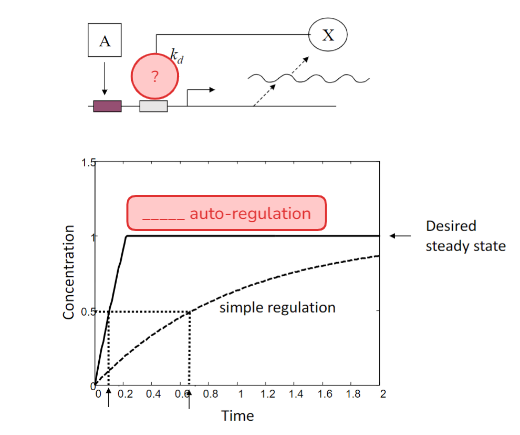
Which type of auto-regulation is shown here?
negative auto-regulation
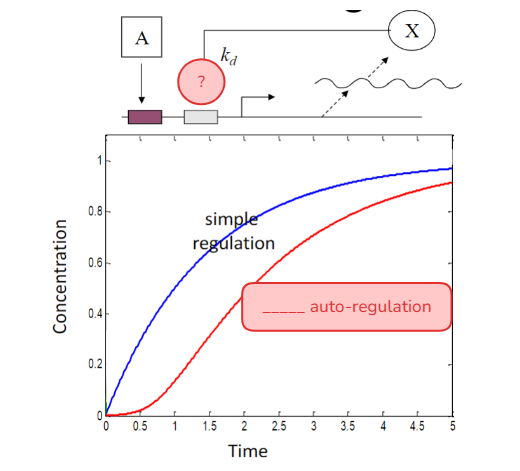
What type of auto-regulation is shown here?
positive auto-regulation
_____ (positive/negative) auto-regulation can use a strong promoter to give an initial fast production and then use autoregulation to stop the production at the desired steady state.
negative
_____ (positive/negative) auto-regulation can use a weaker promoter to give a slower initial production and then use autoregulation to stop the production at the desired steady state.
positive

This image shows a ____ feed-forward loop.
coherent
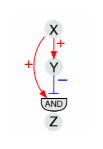
This image shows a _____ feed-forward loop.
incoherent
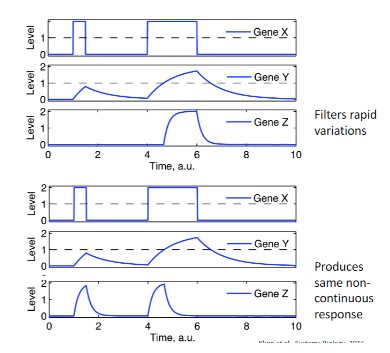
What type of network motif is shown by the top group of data?
coherent feed-forward loop
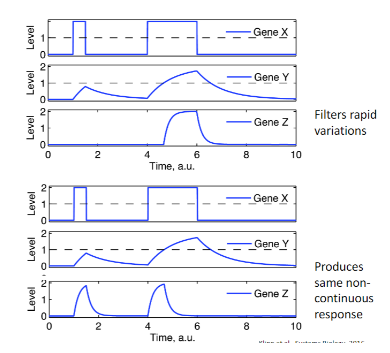
What type of network motif is shown by the bottom group of data?
incoherent feed-forward loop
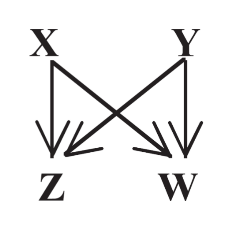
What type of forward network motif is shown here?
bi-fan
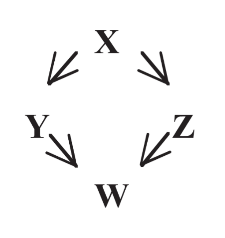
What type of forward network motif is shown here?
bi-parallel
Modular system
a system that consists of autonomous subsystems which perform specific functions
Robustness
the ability to maintain biological function despite perturbations; resistance to change/random forces
How does redundancy provide robustness?
By having several different pathways accomplish the same function; if one pathway fails then other pathways can compensate
Pareto optimality
the trade-off between multiple objectives
Pareto front
a boundary in which none of the objectives can be improved without compromising the other objectives
Select all parts of a systems model that are components:
molecular species
reaction catalysis
rates of interactions
ions
chemical binding and unbinding
regulation of activity
molecular species, ions
Select all parts of a systems model that are interactions:
molecular species
reaction catalysis
rates of interactions
ions
chemical binding and unbinding
regulation of activity
reaction catalysis, chemical binding and unbinding, regulation of activity
What are the kinetic assumptions needed for applying the law of mass action?
rates depend on position in space
individual reaction events cause infinitesimal changes in concentration
fixed volume
only a few molecules of each species present
reaction volume is well stirred
individual reaction events cause infinitesimal changes in concentration, fixed volume, reaction volume is well stirred
The Law of Mass Action states that…
The _____ rate is proportional to the probability of a collision of the reactants
The _____ is proportional to the product of the concentrations of the reactants
reaction, probability
Differential Equation
an equation that relates one or more unknown functions and their derivatives
Ordinary Differential Equation
a differential equation dependent on only a single independent variable

This equation models…
decay
production and decay
irreversible conversion
reversible conversion
enzymatic reaction
spatial reaction networks
stochastic system
predator-prey relationship (Lotka-Volterra)
decay

This equation models…
decay
production and decay
irreversible conversion
reversible conversion
enzymatic reaction
spatial reaction networks
stochastic system
predator-prey relationship (Lotka-Volterra)
production and decay
In this image, to calculate the steady state of a production/decay model, y is the rate of _____ and x is the rate of _____.
decay, production

This equation models…
decay
production and decay
irreversible conversion
reversible conversion
enzymatic reaction
spatial reaction networks
stochastic system
predator-prey relationship (Lotka-Volterra)
irreversible conversion
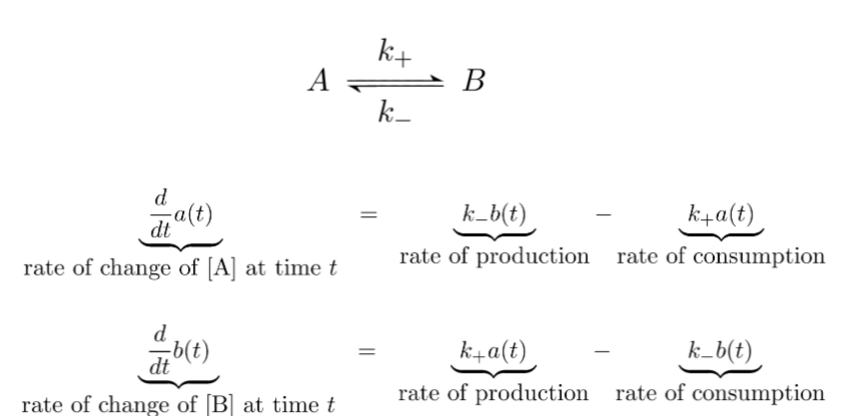
This equation models…
decay
production and decay
irreversible conversion
reversible conversion
enzymatic reaction
spatial reaction networks
stochastic system
predator-prey relationship (Lotka-Volterra)
reversible conversion
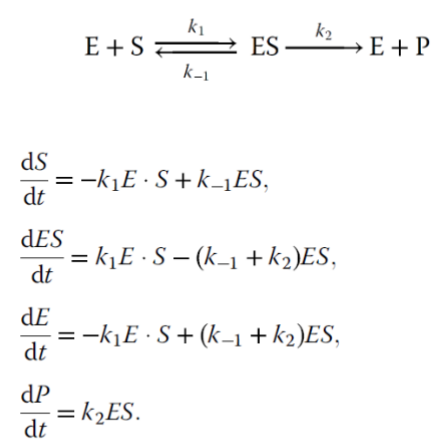
This equation models…
decay
production and decay
irreversible conversion
reversible conversion
enzymatic reaction
spatial reaction networks
stochastic system
predator-prey relationship (Lotka-Volterra)
enzymatic reaction

In the enzymatic reaction shown here, a represents _____.
enzyme binding

In the enzymatic reaction shown here, b represents _____.
enzyme catalysis
Maximal velocity
the maximal rate that can be attained when the enzyme is completely saturated with substrate
Michaelis constant
equal to substrate concentration that yields the half-maximal reaction rate

What does the equation shown here represent?
maximal velocity
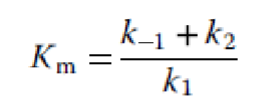
What does the equation shown here represent?
Michaelis constant
Michaelis-Menten Kinetics
a model of enzyme kinetics which explains how the rate of an enzyme-catalysed reaction depends on the concentration of the enzyme and its substrate

The equations shown here are used for what type of model?
Michaelis-Menten kinetics
Euler’s Method
a method for solving ODEs with a given initial value; produces approximate values at a discrete collection of time-points

What is the equation shown here used for?
Euler’s method of solving ODEs
Spatially distributed dynamic behavior can be modeled with which type of equations?
differential equations
ordinary differential equations
partial differential equations
partial differential equations
Partial Differential Equation
an equation that relates one or more unknown functions and their derivatives to time and space

This equation models…
decay
production and decay
irreversible conversion
reversible conversion
enzymatic reaction
spatial reaction networks
stochastic system
predator-prey relationship (Lotka-Volterra)
spatial reaction networks
Intrinsic Noise
noise from within the system; caused by the probabilistic character of (bio)chemical reactions
Extrinsic Noise
noise from within outside the studied system; caused by random fluctuations in environmental parameters
Stochastic Differential Equation
a differential equation that accounts for the presence of noise affecting the results

This equation models…
decay
production and decay
irreversible conversion
reversible conversion
enzymatic reaction
spatial reaction networks
stochastic system
predator-prey relationship (Lotka-Volterra)
stochastic system

This reaction models…
decay
production and decay
irreversible conversion
reversible conversion
enzymatic reaction
spatial reaction networks
stochastic system
predator-prey relationship (Lotka-Volterra)
stochastic system
Stochastic simulations with continuous variables can be modeled using the _____.
Langevin approach
Stochastic simulations with discrete variables can be modeled using the _____.
Gillespie algorithm

What equation is shown here?
Langevin stochastic differential equation

In the Langevin stochastic differential equation, what does the term ξ(t) mean?
noise term
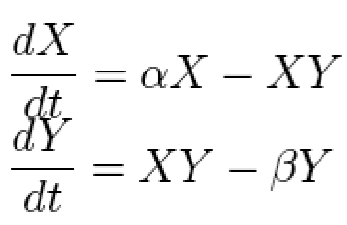
These equations model…
decay
production and decay
irreversible conversion
reversible conversion
enzymatic reaction
spatial reaction networks
stochastic system
predator-prey relationship (Lotka-Volterra)
predator-prey relationship (Lotka-Volterra)
Parameter Estimation
the method of finding a set of parameters that minimizes the difference between experimental data and model prediction

The Sum of Squared Errors equation, shown here, is used for…
parameter estimation
Linear regression can be used for some nonlinear functions, but only under what circumstances?
the function permits a mathematical transformation that makes them linear